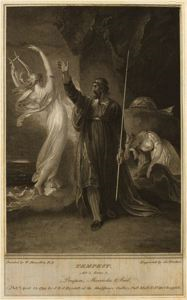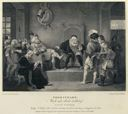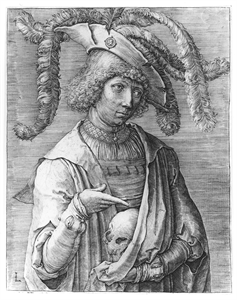
John Boydell
English, 1719–1804
Josiah Boydell (aka Joshua Boydell)
English, 1752–1817
James Parker
English, 1750–1805
after William Hamilton
English, 1751–1801
From Boydell's Graphic Illustrations of the Dramatic Works of Shakespeare
In 1786, a successful London publisher, alderman John Boydell, conceived of a gallery of art devoted to scenes from Shakespeare’s plays. Named for its founder, the Boydell Shakespeare Gallery was one of the first large-scale commercial endeavors intended to promote British literature and artists both in Great Britain as well as throughout the European continent. He commissioned over 167 paintings of scenes from Shakespeare’s plays and produced engravings based on these paintings. In creating the engravings, John Boydell partnered with his son, Josiah, whose name appears after his father’s in the list above. The third name is that of the engraver, and the fourth is that of the painter who created the original composition in oils. The role of the engraver was to transfer the painter’s composition onto plates for printing.
About this scene:
Shakespeare's redemptive plays move beyond tragedy to forgiveness and a new generation’s fresh start.
With magic, the powerful mage and presumed dead former duke of Milan, Prospero, shipwrecks his enemies onto the uncharted island where he has for twelve years lived in exile, hoping to regain his place and provide a suitable husband for his now-grown daughter, all in one afternoon. He tells Miranda of his betrayal by his usurping brother and Alonso, king of Naples, then charms her asleep [seen here], commanding the spirit Ariel to transform to a sea nymph and lead the isolated king’s son Ferdinand to them. Young love blossoms, and then Prospero only has to prompt recognition and repentance in his enemies and himself, subvert murder plots against the king and himself, and renounce magic to achieve his ends—a restored dukedom, promised marriage, and a second chance in life.
-Susan Willis, dramaturg, Alabama Shakespeare Festival, September 28, 2020
English, 1719–1804
Josiah Boydell (aka Joshua Boydell)
English, 1752–1817
James Parker
English, 1750–1805
after William Hamilton
English, 1751–1801
Tempest, Act 1, Scene 2
about 1804From Boydell's Graphic Illustrations of the Dramatic Works of Shakespeare
Object Type:
Print
Dimensions:
10 7/16 x 6 7/16 in. (27 x 16 cm)
Medium and Support:
Engraving on paper
Accession Number:
2016.0008.0001
Credit Line:
Montgomery Museum of Fine Arts Association Purchase
In 1786, a successful London publisher, alderman John Boydell, conceived of a gallery of art devoted to scenes from Shakespeare’s plays. Named for its founder, the Boydell Shakespeare Gallery was one of the first large-scale commercial endeavors intended to promote British literature and artists both in Great Britain as well as throughout the European continent. He commissioned over 167 paintings of scenes from Shakespeare’s plays and produced engravings based on these paintings. In creating the engravings, John Boydell partnered with his son, Josiah, whose name appears after his father’s in the list above. The third name is that of the engraver, and the fourth is that of the painter who created the original composition in oils. The role of the engraver was to transfer the painter’s composition onto plates for printing.
About this scene:
Shakespeare's redemptive plays move beyond tragedy to forgiveness and a new generation’s fresh start.
With magic, the powerful mage and presumed dead former duke of Milan, Prospero, shipwrecks his enemies onto the uncharted island where he has for twelve years lived in exile, hoping to regain his place and provide a suitable husband for his now-grown daughter, all in one afternoon. He tells Miranda of his betrayal by his usurping brother and Alonso, king of Naples, then charms her asleep [seen here], commanding the spirit Ariel to transform to a sea nymph and lead the isolated king’s son Ferdinand to them. Young love blossoms, and then Prospero only has to prompt recognition and repentance in his enemies and himself, subvert murder plots against the king and himself, and renounce magic to achieve his ends—a restored dukedom, promised marriage, and a second chance in life.
-Susan Willis, dramaturg, Alabama Shakespeare Festival, September 28, 2020
Keywords
Click a term to view the records with the same keyword
Related Objects
Click a record to view

Merry Wives of Windsor, Act 5, Scene 5
2016.0008.0002

Much Ado About Nothing, Act 4, Scene 2
2016.0008.0003

Midsummer-Night’s Dream, Act 2, Scene 1
2016.0008.0004

Merchant of Venice, Act 3, Scene 2
2016.0008.0005

Taming of the Shrew, Act 4, Scene 5
2016.0008.0006

Twelfth Night, Act 2, Scene 3
2016.0008.0007

Macbeth, Act 1, Scene 3
2016.0008.0008

Macbeth, Act 5, Scene 1
2016.0008.0009

King Richard II, Act 3, Scene 2
2016.0008.0010

King Henry IV, Part 1, Act 2, Scene 1
2016.0008.0011

King Henry V, Act 3, Scene 3
2016.0008.0012

King Henry VI, Part 1, Act 5, Scene 4
2016.0008.0013

King Richard III, Act 3, Scene 1
2016.0008.0014

Antony and Cleopatra, Act 4, Scene 4
2016.0008.0015

Romeo and Juliet, Act 3, Scene 5
2016.0009.0001

Hamlet, Act 3, Scene 4
2016.0009.0002

Hamlet, Act 4, Scene 7
2016.0009.0003
Portfolio List
Click a portfolio name to view all the objects in that portfolio
This object is a member of the following portfolios:
Your current search criteria is: Keyword is "OL".

 by Artist (9)
by Artist (9)
